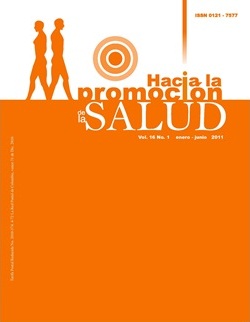Authors
Abstract
Objective: to comparatively evaluate the effects of therapeutic dance on the control of productive stress and the diminishing of stress levels on adults having an active working life. Materials and method: a longitudinal type experimental study that considered a non-probabilistic sample of 30 people classified in three research groups: 10 people who attended the therapeutic dance program, 10 people who performed regular physical activity different from dancing or therapeutic dance, and 10 sedentary executives. Ivanicevich and Matteson's questionnaire was applied to diagnose the level of work stress, and Lamb's test of stress signs was used to determine the signs and symptoms of stress. Results: a high influence of therapeutic dance (99.99%) on stress signs is demonstrated which means that a dance therapeutic program influences positively the stress levels evidenced by the body. Its level of significance on conflictive roles was also evidenced: 99.71%; quantitative role overload: 99.94%; qualitative role overload 99.71%; and leader of the group influence and support: 99.97%. Conclusions: the results of the investigation confirm that stress can decrease with the regular practice of therapeutic dance or physical exercise; in general, the levels of stress decreased significantly in the experimental group. The exercise control group showed a marked tendency to remain constant with slight increases in certain categories related to working life stress. In the sedentary control group a significant trend towards higher levels of stress in most categories was found.
Keywords
References
Panhofer H. El cuerpo en psicoterapia: Teoría y práctica de la Danza Movimiento Terapia. España: Gedisa S.A.; 2005.
Caicedo M. La danza como estrategia en el quehacer de la fisioterapia. Cuerpo-movimiento: perspectivas. Santafé de Bogotá: Universidad del Rosario; 2005. p. 207-19.
Guizar R. Administración del estrés. Desarrollo organizacional. México: Mc Graw – Hill; 1997.
Diccionario de Medicina Oceano Mosby. Barcelona: Oceano; 1999.
Pereyra M. Estres y Salud. México: Universidad Montemorelos; 2010 [cited 2010]; Available from: http://mpereyra.com/archivos/EstresySalud.pdf.
Slipark O. Estres laboral. Alcmeon: Revista Argentina de Clínica Neuropsiquiátrica. 1996;4.
Cordero V LE. Factores de riesgo psicosociales. Documento técnico de protección laboral. Santafé de Bogota: I.S.S. Libros y libros; 1996.
Ivanicevich J, Matteson M. Estrés y trabajo: Una perspectiva gerencial. México: Trillas; 1989.
Lopez M AL. Actividad física, deporte y salud empresarial. Medicina del deporte y salud empresarial. Cali: Universidad Libre. Feriva S.A.; 2008. p. 107.
Toro R. Biodanza. Chile: Indigo; 2001.
Fariñas G. Psicoballet. [Página web. Video] Cuba2009 [cited 2009]; Available from: http://cencomed.sld.cu/psicoballet/main.htmhttp://www.youtube.com/watch?v=XUwI-pTJpO4.
Fux M. Primer encuentro con la danzoterapia. Buenos Aires: Paidos; 1982.
Berge I. Vivir tu cuerpo. para una pedagogía del movimiento. Madrid: Narcea S. A.; 1985.
Bossu H, Chalaguier C. La expresión corporal; enfoque metodológico y perspectivas pedagógicas Barcelona: Martínez Roca; 1985.
Stokoe P, Schachter A. La expresión corporal. Barcelona: Paídos: Colección técnicas y lenguajes corporales; 1986.
Le du J. El cuerpo hablado: psicoanálisis de la expresión corporal. Barcelona, España: Paidos: Colección técnicas y lenguajes corporales; 1992.
Arteaga M. Desarrollo de la Expresividad Corporal 1999. Barcelona: INDE; 1999.
Hawse J. Técnica de la danza y prevención de lesiones. España: Paidotribo; 2000.
Franklin E. Danza: Acondicionamiento Físico. . España: Paidotribo.; 2006.
Ritmos Latinoamericanos. Bogota, D.C: Legis; 2007.
Londoño A. Baila Colombia. Medellín: Universidad de Antioquia; 1996.
Natale F. Danza Trance. Barcelona: Integral; 1996.
Medina NM. Psicodanza: Una terapia de contacto. Buenos Aires: Paidos; 1982.
Alvin J. Musicoterapia España: Editorial Paidos; 1984.
Feldenkrais M. Autoconciencia por el movimiento. Ejercicios para el desarrollo personal. España: Paidos 1991.
Hency de G V. Aproximación a la eutonía: Conversación con Gerda Alexander. Buenos Aires: Paidos; 1991.
Scshilder P. Imagen y Apariencia del Cuerpo Humano. México: Paidos; 1987.
Reca M. Qué es Danza/movimiento terapia. El cuerpo en danza. Buenos Aires: Lumen; 2005.
Corsino LE. Prescripción del ejercicio para el baile aeróbico. Saludmen; 2009 [updated Saludmed; cited 2010]; Disponible en : http://www.saludmed.com/Bienestar/Cap2/Rx-BaAer.html.
Company K. Zumba Fitness® launched. 2010 [cited 2010]; Disponible en: http://www.zumba.com/us/.
JPCardiodance. JPCardioDance México2009 [cited 2010]; Disponible en: http://www.jpcardiodance.com/.
Tercedor P, Jiménez MJ, López B. La promoción de la actividad física orientada hacia la salud. Un camino por hacer. REVISTA MOTRICIDAD. 1998;4:203-17.
Devis J, Peiro V C, Perez S Vyo. Actividad Física, Deporte y Salud. España: INDE; 2002.
French JRP, Caplan RD. Job demands and worker health; main effects and occupational differences Washington, D.C: DHEW; 1975.


 PDF (Español)
PDF (Español)
 FLIP
FLIP






















